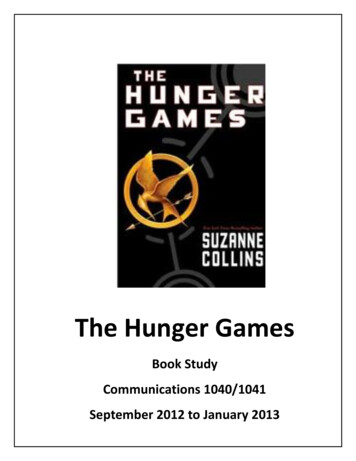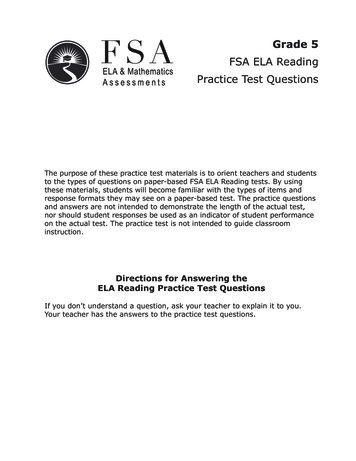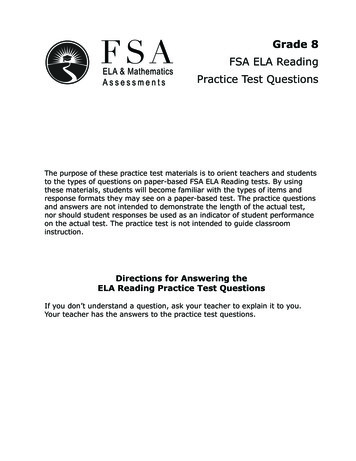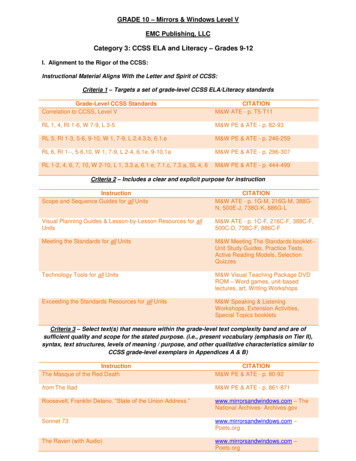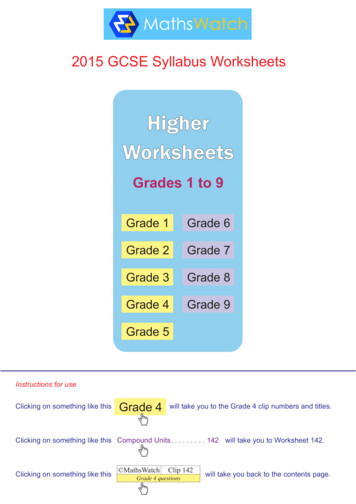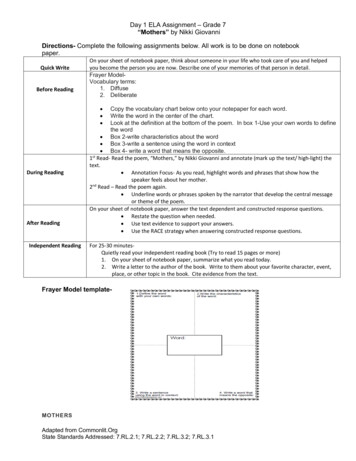
Transcription
Day 1 ELA Assignment – Grade 7“Mothers” by Nikki GiovanniDirections- Complete the following assignments below. All work is to be done on notebookpaper.Quick WriteBefore ReadingOn your sheet of notebook paper, think about someone in your life who took care of you and helpedyou become the person you are now. Describe one of your memories of that person in detail.Frayer ModelVocabulary terms:1. Diffuse2. Deliberate During ReadingAfter ReadingIndependent ReadingCopy the vocabulary chart below onto your notepaper for each word.Write the word in the center of the chart.Look at the definition at the bottom of the poem. In box 1-Use your own words to definethe word Box 2-write characteristics about the word Box 3-write a sentence using the word in context Box 4- write a word that means the opposite.1st Read- Read the poem, “Mothers,” by Nikki Giovanni and annotate (mark up the text/ high-light) thetext. Annotation Focus- As you read, highlight words and phrases that show how thespeaker feels about her mother.2nd Read – Read the poem again. Underline words or phrases spoken by the narrator that develop the central messageor theme of the poem.On your sheet of notebook paper, answer the text dependent and constructed response questions. Restate the question when needed. Use text evidence to support your answers. Use the RACE strategy when answering constructed response questions.For 25-30 minutesQuietly read your independent reading book (Try to read 15 pages or more)1. On your sheet of notebook paper, summarize what you read today.2. Write a letter to the author of the book. Write to them about your favorite character, event,place, or other topic in the book. Cite evidence from the text.Frayer Model template-MOTHERSAdapted from Commonlit.OrgState Standards Addressed: 7.RL.2.1; 7.RL.2.2; 7.RL.3.2; 7.RL.3.1
Day 1 ELA Assignment – Grade 7“Mothers” by Nikki Giovanniby Nikki Giovanni 1972[1] the last time i was hometo see my mother we kissedexchanged pleasantriesand unpleasantries pulled a warm[5] comforting silence aroundus and read separate booksPleasantriesUnpleasantriesi remember the first timei consciously saw herwe were living in a three room[10] apartment on burns avenuemommy always sat in the darki don’t know how i knew that but she didthat night i stumbled into the kitchenmaybe because i’ve always been[15] a night person or perhaps because i had wetthe bedshe was sitting on a chairthe room was bathed in moonlight diffusedthroughthose thousands of panes landlords who rented[20] to people with children were prone to put inwindowsshe may have been smoking but maybe nother hair was three-quarters her heightwhich made me a strong believer in the samson mythand very black[25] i’m sure i just hung there by the doori remember thinking: what a beautiful ladyshe was very deliberately waitingperhaps for my father to come homefrom his night job or maybe for a dream[30] that had promised to come by“come here” she said “i’ll teach youa poem:i see the moonthe moon sees me[35] god bless the moonand god bless me”i taught it to my sonwho recited it for herjust to say we must learn[40]to bear the pleasuresas we have borne the painsDiffuse (verb): to spread over a wide areaSamson a character in the Hebrew Bible who would lose his incredible strength if his hair was cutDeliberate (adjective):done or said in a way that is planned or intended; done or said on purposeText Dependent Multiple-Choice Questions1. PART A: Which of the following identifies a theme of the poem?A. As children grow up, their views of their mothers evolve and changeAdapted from Commonlit.OrgState Standards Addressed: 7.RL.2.1; 7.RL.2.2; 7.RL.3.2; 7.RL.3.1
Day 1 ELA Assignment – Grade 7“Mothers” by Nikki GiovanniB. The most important lessons that children can learn come from mothers.C. As children grow up, they will, without a doubt, grow apart from their mothers.D. Children only come to truly understand their mothers when they become parentsthemselves.2. PART B: Which section from the text best supports the answer to Part A?A. “the last time i was home / to see my mother we kissed / exchanged pleasantries”(Lines 1-3)B. “i remember the first time / i consciously saw her / we were living in a threeroom/apartment” (Lines 7-10)C. “mommy always sat in the dark / i don’t know how i knew that but she did” (Lines 1112)D. “her hair was three-quarters her height / which made me a strong believer in thesamson myth” (Lines 22-23)3. PART A: How does the speaker’s view of her mother change as she grows older?A. When she is a child, she views her mother as an almost mystical being, but when she isan adult, she views her more realistically.B. When she is a child, she views her mother as average, but when she is an adult, sheviews her as a larger-than-life figure.C. When she is a child, she views her mother with a sense of jealousy, but when she is anadult, she views her with admiration and respect.D. When she is a child, she views her mother negatively, but when she is an adult, sheviews her with more understanding.4. PART B: Which Two details from the text best support the answer to Part A?A. “the last time i was home / to see my mother we kissed / exchanged pleasantries / andunpleasantries” (Lines 1-4)B. “i remember the first time / i consciously saw her / we were living in a three room”(Lines 7-9)C. “mommy always sat in the dark / i don’t know how i knew that but she did” (Lines 1112)D. “i’m sure i just hung there by the door / i remember thinking: what a beautiful lady”(Lines 25-26)E. “i taught it to my son / who recited it for her” (Lines 36-37)F. “we must learn / to bear the pleasures / as we have borne the pains” (Lines 38-40) 3Constructed Response Questions:5. How does the author’s inclusion of the poem within the poem (Lines 32-35) develop thetheme of the text?6. How has growing up influenced your views on your parents?7. In the context of the poem, what makes a family? What might the speaker of the poem saymakes a family? How does this poem depict the role of mothers in families?8. In the context of the poem, how does love emerge? How does the author describe her lovefor her mother? How does this love evolve throughout the poem?Adapted from Commonlit.OrgState Standards Addressed: 7.RL.2.1; 7.RL.2.2; 7.RL.3.2; 7.RL.3.1
GRADE 7 MATHNAMEDATEPERIODDay 1.1Unit 5, Lesson 1: Interpreting Negative NumbersLet's review what we know about signed numbers. (6.NS.1)1.1: Using the ThermometerHere is a weather thermometer. Three of the numbers have been left off.1.What numbers go in the boxes?2.What temperature does the thermometer show?Unit 5, Lesson 1: Interpreting Negative NumbersDownload for free at openupresources.org1
GRADE 7 MATHNAMEDATEPERIOD1.2: Fractions of a Degree1.What temperature is shown on each thermometer below?2.Which thermometer shows the highest temperature?3.Which thermometer shows the lowest temperature?4.Suppose the temperature outside is -4 C. Is that colder or warmer than the coldest temperatureshown? How do you know?Unit 5, Lesson 1: Interpreting Negative NumbersDownload for free at openupresources.org2
GRADE 7 MATHNAMEDATEPERIOD1.3: Seagulls Soar, Sharks SwimHere is a picture of some sea animals. The number line on the left shows the vertical position of eachanimal above or below sea level, in meters.1.How far above or below sea level is each animal? Use their eye level to find their vertical position.Unit 5, Lesson 1: Interpreting Negative NumbersDownload for free at openupresources.org3
GRADE 7 MATHNAME2.DATEPERIODA mobula ray is 3 meters above the surface of the ocean. How does its distance from the surface ofthe ocean compare to the vertical distance from the eyes of:The jumping dolphin?The flying seagull?The octopus?3.An albatross is 5 meters above the surface of the ocean. How does its distance from the surfacecompare to the vertical distance from the eyes of:The jumping dolphin?The flying seagull?The octopus?4.A clownfish is 2 meters below the surface of the ocean. How does its distance from the surfacecompare to the vertical distance from the eyes of:The jumping dolphin?The flying seagull?The octopus?5.The vertical distance of a new dolphin from the dolphin in the picture is 3 meters. What is itsdistance from the surface of the ocean?Are you ready for more?The north pole is in the middle of the ocean. A person at sea level at the north pole would be 3,949miles from the center of the earth. The sea floor below the north pole is at an elevation ofapproximately -2.7 miles. The elevation of the south pole is about 1.7 miles. How far is a person standingon the south pole from a submarine at the sea floor below the north pole?Unit 5, Lesson 1: Interpreting Negative NumbersDownload for free at openupresources.org4
GRADE 7 MATHNAMEDATEPERIOD1.4: Card Sort: Rational Numbers1.Cut out the two sets of rational number cards and place them in a bag.2.Place your hand in the bag and pull out five (5) number cards. Order the cards from least togreatest. Write the numbers on the line below. (Note: Do not put the used cards back in the bag.)3.Repeat Step 2 four more rounds.Order from least to greatest:Round 1Round 2Round 3Round 4Round 5Lesson 1 SummaryWe can use positive and negative numbers to represent temperature and elevation.When numbers represent temperatures, positive numbers indicate temperatures that are warmer thanzero and negative numbers indicate temperatures that are colder than zero. This thermometer shows atemperature of -1 degree Celsius, which we write -1 C.When numbers represent elevations, positive numbers indicate positions above sea level and negativenumbers indicate positions below sea level.We can see the order of signed numbers on a number line.A number is always less than numbers to its right. So -7 -3.We use absolute value to describe how far a number is from 0. The numbers 15 and -15 are both 15units from 0, so 15 15 and -15 15. We call 15 and -15 opposites. They are on opposite sides of0 on the number line, but the same distance from 0.Unit 5, Lesson 1: Interpreting Negative NumbersDownload for free at openupresources.org5
Blackline Master for Classroom Activity 7.5.1.4: Card Sort: Rational NumbersSet 1 load for free at openupresources.org
Blackline Master for Classroom Activity 7.5.1.4: Card Sort: Rational NumbersSet 2 (Rational numbers that are not integers)14981-45565-5 62.5839-8-2.58-37.73133228-7.731-33-22 8Download for free at openupresources.org
GRADE 7 MATHNAMEDATEPERIODDay 1.1Unit 5, Lesson 1: Cool-down1.5: Signed Numbers!!Here is a set of signed numbers: 7, -3, ", -0.8, 0.8, -!#, -21.Order the numbers from least to greatest.2.If these numbers represent temperatures in degrees Celsius, which is the coldest?3.If these numbers represent elevations in meters, which is the farthest away from sea level?Unit 5, Lesson 1: Cool-downDownload for free at openupresources.org1
GRADE 7 MATHNAMEDATEPERIODDay 1.1Unit 5, Lesson 1: Practice Problems1.It was -5 C in Copenhagen and -12 C in Oslo. Which city was colder?2.3.a.A fish is 12 meters below the surface of the ocean. What is its elevation?b.A sea bird is 28 meters above the surface of the ocean. What is its elevation?c.If the bird is directly above the fish, how far apart are they?Compare using , , or .a.3 -3b.12 24c.-12 -24d.5 -(-5)e.7.2 7f.-7.2 -7g.-1.5h.-'i.-%j.-&((%-%&-('-)* *%Unit 5, Lesson 1: Practice ProblemsDownload for free at openupresources.org1
GRADE 7 MATHNAMEDATEPERIODDay 1.2Unit 5, Lesson 2: Changing TemperaturesLet's add signed numbers. (7.C.1)2.1: Warmer and Colder1.Complete the table and draw a number line diagram for each situation.start ( C)change ( C)final ( C)addition equationa 4010 degrees warmer 5040 10 50b 405 degrees colderc 4030 degrees colderd 4040 degrees coldere 4050 degrees coldera.b.c.d.e.Unit 5, Lesson 2: Changing TemperaturesDownload for free at openupresources.org1
GRADE 7 MATHNAME2.DATEPERIODComplete the table and draw a number line diagram for each situation.start ( C)change ( C)a-2030 degrees warmerb-2035 degrees warmerc-2015 degrees warmerd-2015 degrees colderfinal ( C)addition equationa.b.c.d.Are you ready for more?For the numbers 𝑎 and 𝑏 represented in the figure, which expression is equal to 𝑎 𝑏 ? 𝑎 𝑏 𝑎 𝑏 𝑏 𝑎 Unit 5, Lesson 2: Changing TemperaturesDownload for free at openupresources.org2
GRADE 7 MATHNAMEDATEPERIOD2.2: Winter TemperaturesInteractive digital version -5-2-3One winter day, the temperature in Houston is 8 Celsius. Find the temperatures in these other cities.Explain or show your reasoning.1.In Orlando, it is 10 warmer than it is in Houston.2.In Salt Lake City, it is 8 colder than it is in Houston.3.In Minneapolis, it is 20 colder than it is in Houston.4.In Fairbanks, it is 10 colder than it is in Minneapolis.5.Write an addition equation that represents the relationship between the temperature in Houstonand the temperature in Fairbanks.Lesson 2 SummaryIf it is 42 outside and the temperature increases by 7 , then we can add the initial temperature and thechange in temperature to find the final temperature.42 7 49If the temperature decreases by 7 , we can either subtract 42 7 to find the final temperature, or wecan think of the change as -7 . Again, we can add to find the final temperature.42 (-7) 35In general, we can represent a change in temperature with a positive number if it increases and anegative number if it decreases. Then we can find the final temperature by adding the initialtemperature and the change. If it is 3 and the temperature decreases by 7 , then we can add to findthe final temperature.3 (-7) -4Unit 5, Lesson 2: Changing TemperaturesDownload for free at openupresources.org3
GRADE 7 MATHNAMEDATEPERIODWe can represent signed numbers with arrows on a number line. We can represent positive numberswith arrows that start at 0 and points to the right. For example, this arrow represents 10 because it is10 units long and it points to the right.We can represent negative numbers with arrows that start at 0 and point to the left. For example, thisarrow represents -4 because it is 4 units long and it points to the left.To represent addition, we put the arrows “tip to tail.” So this diagram represents 3 5:And this represents 3 (-5):Unit 5, Lesson 2: Changing TemperaturesDownload for free at openupresources.org4
GRADE 7 MATHNAMEDATEPERIODDay 1.2Unit 5, Lesson 2: Cool-down2.4: Stories about Temperature1.Write a story about temperatures that this expression could represent: 27 (-11)2.Draw a number line diagram and write an expression to represent this situation: “On Tuesday atlunchtime, it was 29 C. By sunset, the temperature had dropped to 16 C.”Unit 5, Lesson 2: Cool-downDownload for free at openupresources.org1
GRADE 7 MATHNAMEDATEPERIODDay 1.2Unit 5, Lesson 2: Practice Problems1.2.3.a.The temperature is -2 C. If the temperature rises by 15 C, what is the new temperature?b.At midnight the temperature is -6 C. At midday the temperature is 9 C. By how much didthe temperature rise?Complete each statement with a number that makes the statement true.a. 7 Cb. -3 Cc.-0.8 C -0.1 Cd. -2 CDraw a diagram to represent each of these situations. Then write an addition expression thatrepresents the final temperature.a.The temperature was 80 F and then fell 20 F.b.The temperature was -13 F and then rose 9 F.c.The temperature was -5 F and then fell 8 F.Unit 5, Lesson 2: Practice ProblemsDownload for free at openupresources.org1
GRADE 7 MATHNAMEDATEPERIODDay 1.3Unit 5, Lesson 3: Changing ElevationLet's solve problems about adding signed numbers. (7.C.1)3.1: That's the Opposite1.Draw arrows on a number line to represent these situations:a.The temperature was -5 degrees. Then the temperature rose 5 degrees.b.A climber was 30 feet above sea level. Then she descended 30 feet.2.What’s the opposite ofa.running 150 feet east?b.jumping down 10 steps?c.pouring 8 gallons into a fish tank?Unit 5, Lesson 3: Changing ElevationDownload for free at openupresources.org1
GRADE 7 MATHNAMEDATEPERIOD3.2: Cliffs and CavesInteractive digital version -5-3-21.A mountaineer is climbing on a cliff. She is 400 feet above the ground. If she climbs up, this will bea positive change. If she climbs down, this will be a negative change.a.Complete the table.startingelevation(feet)change(feet)A 400300 upB 400150 downC 400400 downD 400finalelevation(feet) 50b.Write an addition equation and draw a number line diagram for B. Include the startingelevation, change, and final elevation in your diagram.Unit 5, Lesson 3: Changing ElevationDownload for free at openupresources.org2
GRADE 7 MATHNAME2.DATEPERIODA spelunker is down in a cave next to the cliff. If she climbs down deeper into the cave, this will bea negative change. If she climbs up, whether inside the cave or out of the cave and up the cliff, thiswill be a positive change.a.Complete the table.startingelevation(feet)change(feet)A-200150 downB-200100 upC-200200 upD-200250 upE-200finalelevation(feet)-500b. Write an addition equation and draw a number line diagram for rows C and D. Include thestarting elevation, change, and final elevation in your diagram.c. What does the expression -75 100 tell us about the spelunker? What does the value ofthe expression tell us?Unit 5, Lesson 3: Changing ElevationDownload for free at openupresources.org3
GRADE 7 MATHNAMEDATEPERIOD3.3: Adding Rational NumbersFind the sums.1.-35 (30 5)2.-0.15 (-0.85) 12.53.,-. (- /)Are you ready for more?Find the sum without a calculator.10 21 32 43 54 (-54) (-43) (-32) (-21) (-10)Unit 5, Lesson 3: Changing ElevationDownload for free at openupresources.org4
GRADE 7 MATHNAMEDATEPERIODLesson 3 SummaryThe opposite of a number is the same distance from 0 but on the other side of 0.The opposite of -9 is 9. When we add opposites, we always get 0. This diagram shows that 9 -9 0.When we add two numbers with the same sign, the arrows that represent them point in the samedirection. When we put the arrows tip to tail, we see the sum has the same sign.To find the sum, we add the magnitudes and give it the correct sign. For example, (-5) (-4) -(5 4).On the other hand, when we add two numbers with different signs, we subtract their magnitudes(because the arrows point in the opposite direction) and give it the sign of the number with the largermagnitude. For example, (-5) 12 (12 5).Unit 5, Lesson 3: Changing ElevationDownload for free at openupresources.org5
GRADE 7 MATHNAMEDATEPERIODUnit 5, Lesson 3: Cool-down3.5: Add 'Em UpFind each sum.1.2.56 (-56)-240 3703.-5.7 (-4.2)Unit 5, Lesson 3: Cool-downDownload for free at openupresources.org1
GRADE 7 MATHNAMEDATEPERIODDay 1.3Unit 5, Lesson 3: Practice Problems1.2.3.What is the final elevation ifa.A bird starts at 20 m and changes 16 m?b.A butterfly starts at 20 m and changes -16 m?c.A diver starts at 5 m and changes -16 m?d.A whale starts at -9 m and changes 11 m?e.A fish starts at -9 meters and changes -11 meters?One of the particles in an atom is called an electron. It has a charge of -1. Another particle in anatom is a proton. It has charge of 1. The charge of an atom is the sum of the charges of theelectrons and the protons. A carbon atom has an overall charge of 0, because it has 6 electrons and6 protons and -6 6 0. Find the overall charge for the rest of the elements on the list.charge fromelectronscharge fromprotonsoverallchargecarbon-6 60neon-10 10oxide-10 8copper-27 29tin-50 50Add.a.14.7 28.9b.c.-9.2 4.4-81.4 (-12)d.51.8 (-0.8)Unit 5, Lesson 3: Practice ProblemsDownload for free at openupresources.org1
D. "her hair was three-quarters her height / which made me a strong believer in the samson myth" (Lines 22-23) 3. PART A: How does the speaker's view of her mother change as she grows older? A. When she is a child, she views her mother as an almost mystical being, but when she is an adult, she views her more realistically. B.

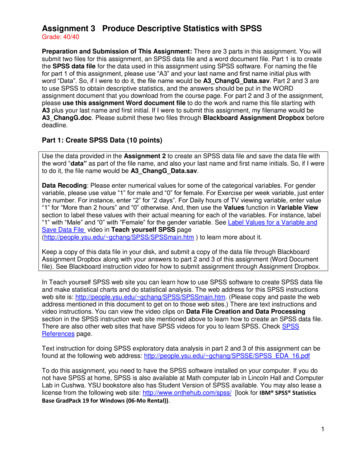
![Welcome [dashdiet.me]](/img/17/30-day-weight-loss-journal.jpg)

